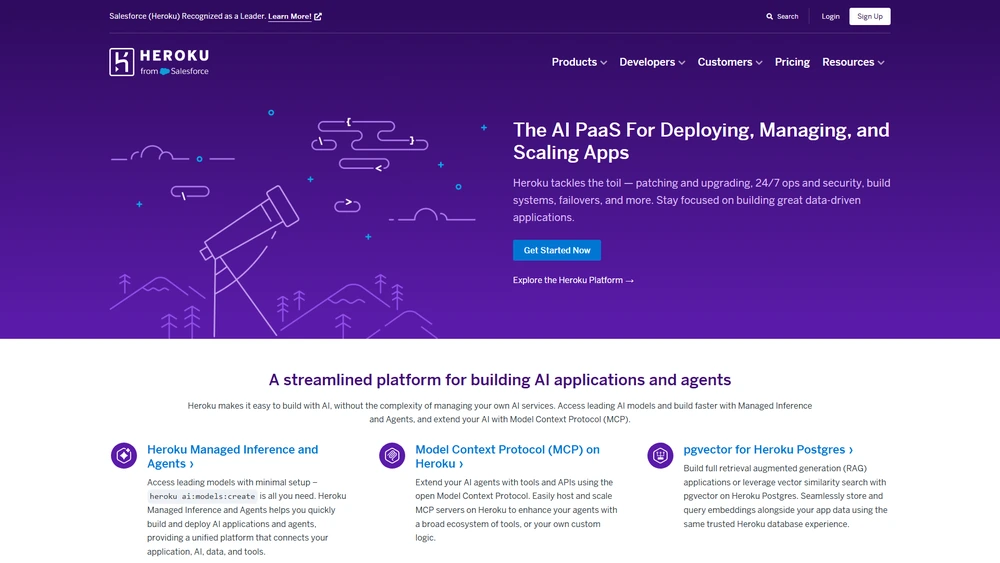Heroku Overview & 2025 Industry Position
Heroku is a cloud-based platform-as-a-service (PaaS) that enables developers to build, run, and operate applications entirely in the cloud. As part of the Salesforce ecosystem, Heroku has long stood at the intersection of app deployment and DevOps simplicity. In 2025, it reinforces its relevance with robust container support, auto-scaling capabilities, and deeper integration with modern developer workflows. Whether launching a side project or managing production-scale environments, Heroku continues to offer a blend of ease and scalability that appeals to startups, agencies, and enterprise teams alike.
From Launch to 2025: Heroku’s Journey
Heroku was founded in 2007 as one of the first cloud PaaS providers with a focus on Ruby applications. It was acquired by Salesforce in 2010, which broadened its strategic positioning within the enterprise software market.
- 2009: General availability for Ruby on Rails deployments
- 2011: Added support for Node.js, Python, Java, and more
- 2015: Introduction of Heroku Button and Pipelines
- 2018: Container registry and runtime improvements
- 2023: Revamped pricing model and improved dyno performance
- 2025: Focus on composability, AI-enable automation, and developer productivity
Heroku’s 2025 strategy hinges on extensibility, low-friction DX (developer experience), and alignment with the rapid growth of AI-driven, event-based architectures.

Heroku Key Features
Heroku’s platform stands out through its focus on simplicity, scalability, and developer ergonomics. Key 2025 features include:
- Dynos (Containers): Lightweight containers that automatically scale vertically and horizontally with traffic.
- Buildpacks: Support for official and custom languages including Node.js, Python, Ruby, Java, PHP, and Go.
- Heroku Postgres: Managed PostgreSQL database service with powerful analytics features.
- Private Spaces: Isolated runtime environments for teams requiring compliance or dedicated networking.
- Autoscaling: Automatically adjusts app instances based on response time and load conditions.
- Heroku Connect: Seamlessly sync data between your Heroku app and Salesforce CRM.
- CLI & Dashboard: Command-line and web-based management tools for real-time control and visibility.
- Pipelines: Visual CI/CD integrations via Heroku Pipelines and GitHub compatibility.
Workflow & UX
Heroku’s appeal lies in how it abstracts server management into an intuitive, developer-first experience. Users push code via Git, and the system handles compilation, deployment, provisioning, and routing. The workflow integrates directly with GitHub, allowing automatic builds and test pipelines. The Heroku Dashboard offers an ideal balance: easy for newcomers but deep enough for professionals managing multi-region setups.
Heroku Pricing Analysis & Value Metrics
As of July 2025, Heroku offers a consumption-based pricing model with better granularity than in previous years:
| Plan | Price / Dyno / Month | Key Features |
|---|---|---|
| Free | $0 | 500 credits/month, sleeps after inactivity, best for prototypes |
| Eco | $5 | 1,000 credits/month, pre-sleep warning, great for hobby projects |
| Basic | $10 | 24/7 uptime, 512MB RAM, ideal for small apps |
| Standard 1X | $25 | 512MB RAM, production-ready, auto-scaling enabled |
| Performance-M | $250 | 2.5GB RAM, private dyno networking |
| Enterprise | Custom | Private Spaces, compliance, dedicated support |
Heroku’s pricing remains competitive in 2025, especially for small to medium apps looking to save engineering time.
Competitive Landscape
| Platform | Best For | Main Differentiator |
|---|---|---|
| Heroku | Simplicity, rapid deployment | Managed pipelines, Salesforce integration |
| Render | Modern startups | Cheaper base pricing, custom domains |
| Vercel | Frontend-heavy apps | Optimized for Next.js |
| Google Cloud Run | Enterprise apps | Per-request billing, flexible runtime |
| AWS Elastic Beanstalk | Enterprises and sysadmins | Tight AWS service coupling |
Use Cases
From solo developers to enterprise teams, Heroku supports diverse production and staging environments:
- Startups: Quickly launch MVPs and iterate with CI/CD workflows.
- E-commerce: Integrate payment processing and commerce APIs efficiently.
- CRM Apps: Build tightly integrated apps alongside Salesforce Cloud.
- Agencies: Deploy and manage multiple client projects from one dashboard.
Integrations Ecosystem
Heroku boasts one of the largest PaaS add-on marketplaces with over 200+ services:
- Databases: Heroku Postgres, Redis, Kafka
- Monitoring: New Relic, LogDNA, Sentry
- Payments: Stripe, Square
- Auth & Identity: Auth0, Okta, Firebase Auth
Pros & Cons
- Pros:
• Clean developer experience
• Predictable deployment and rollback
• Rich third-party integrations - Cons:
• Higher cost at scale
• Limited regional availability
• Support tiers locked behind Enterprise
Final Thoughts
Heroku remains a beacon of simplicity for developers in 2025. Its focus on managed deployments, deep integrations, and automated scaling make it an ideal choice for teams prioritizing speed to market over infrastructure complexity. While higher usage apps may hit cost ceilings, the value in developer time saved cannot be understated.
Pro Tip: Use Heroku Pipelines alongside GitHub Actions to create fully automated feature-to-production launches in minutes.
Heroku FAQ
Heroku supports Node.js, Ruby, Java, Python, PHP, and Go. You can also use custom buildpacks for additional languages.
Yes, the Free and Eco plans allow limited usage—ideal for prototyping or personal projects.
Yes. Heroku provides automatic scaling for Standard and Performance plans based on response times or manual triggers.
No. Heroku’s Private Spaces and Enterprise plans scale to support large-scale apps with compliance and SLAs.
Through Heroku Connect, which synchronizes data bi-directionally between Salesforce objects and Heroku Postgres databases.

